
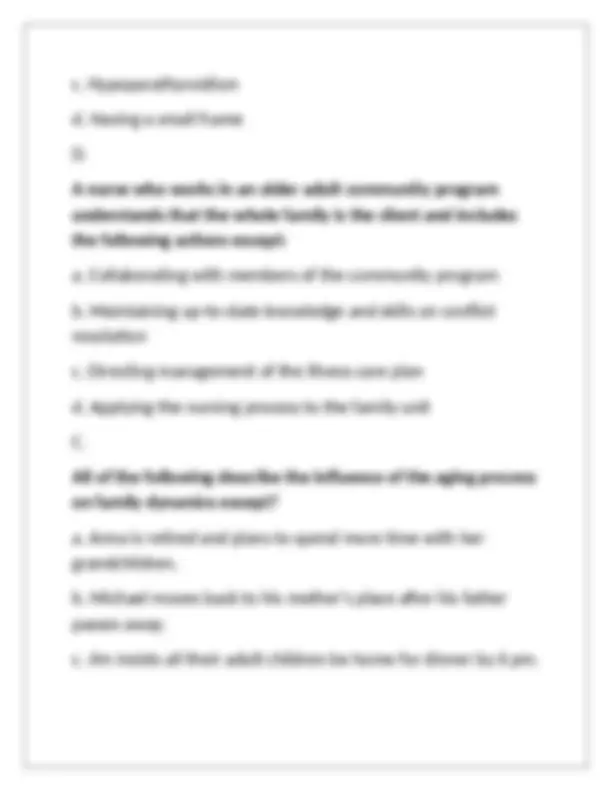
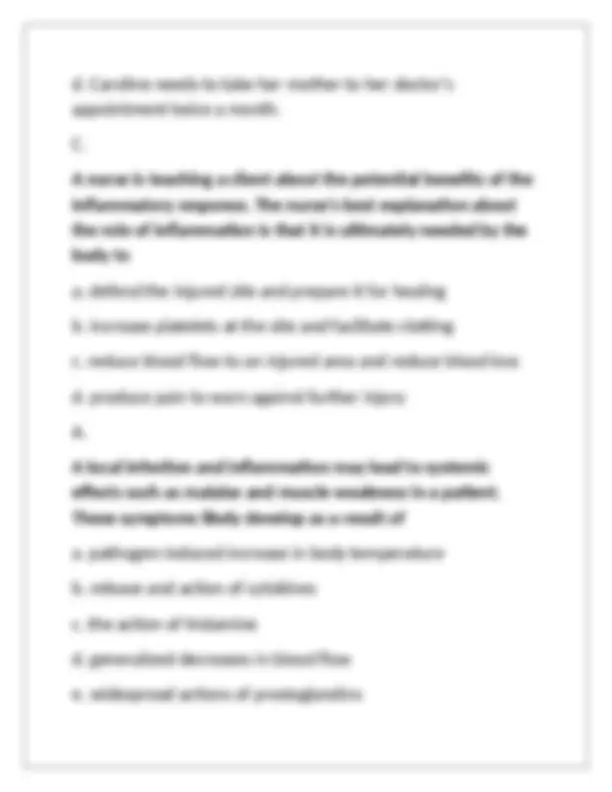
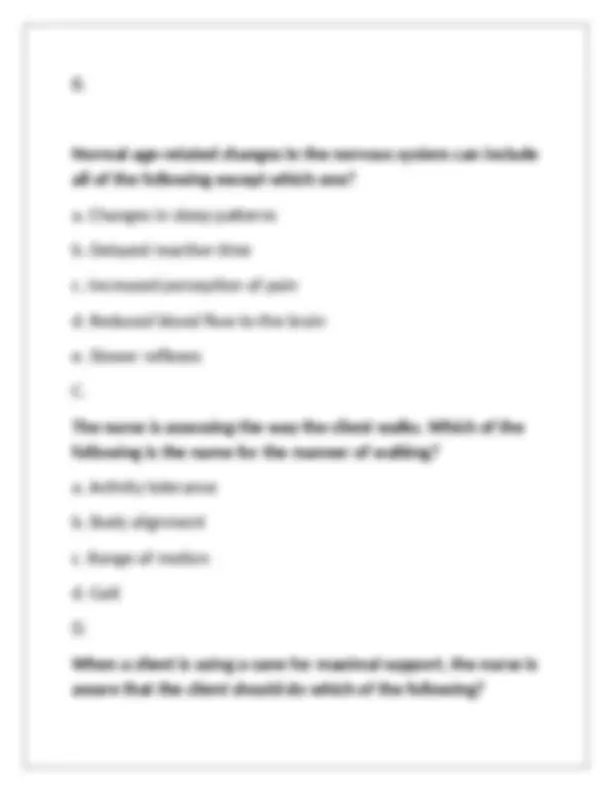
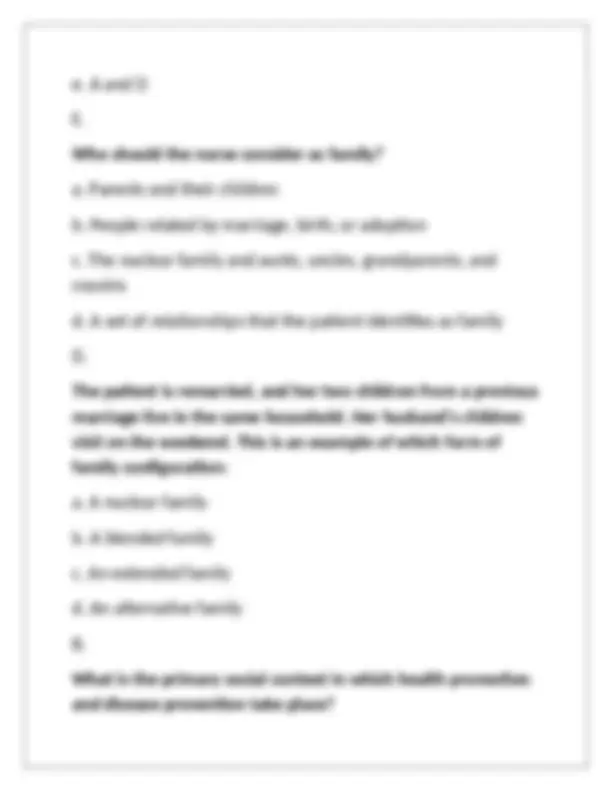
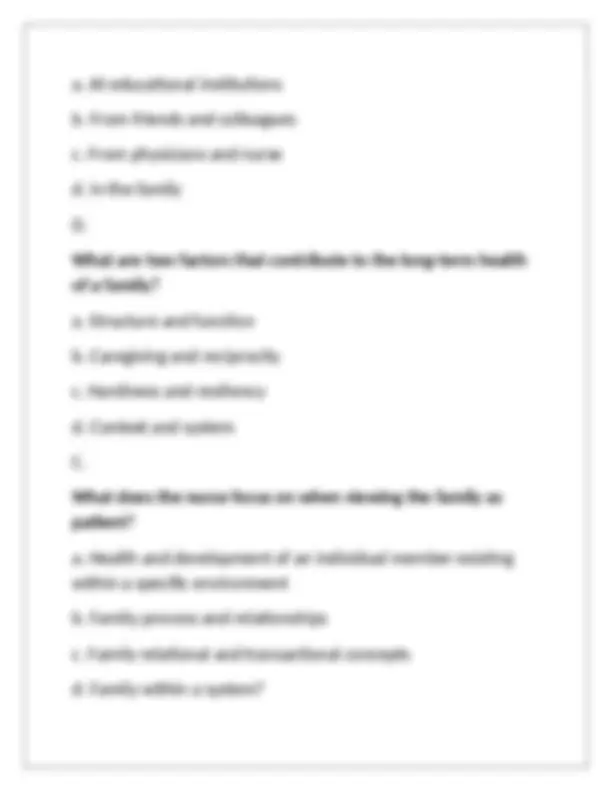
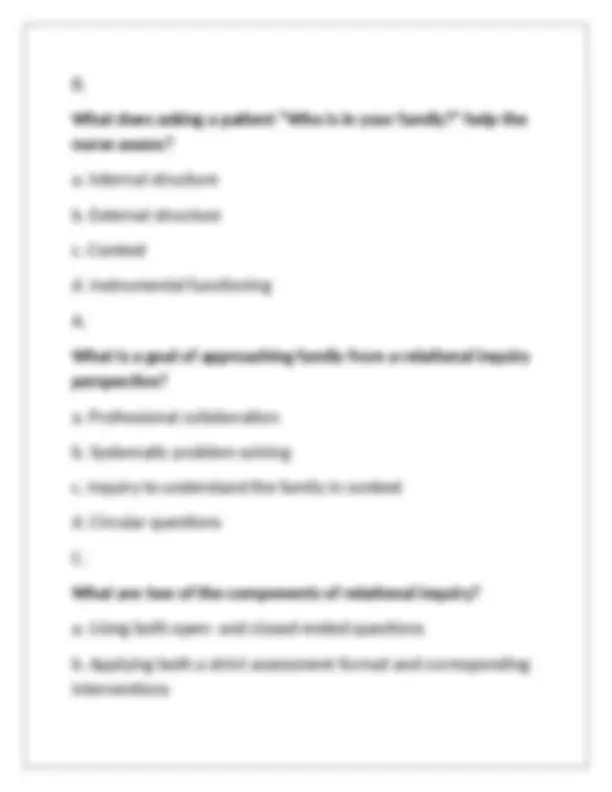
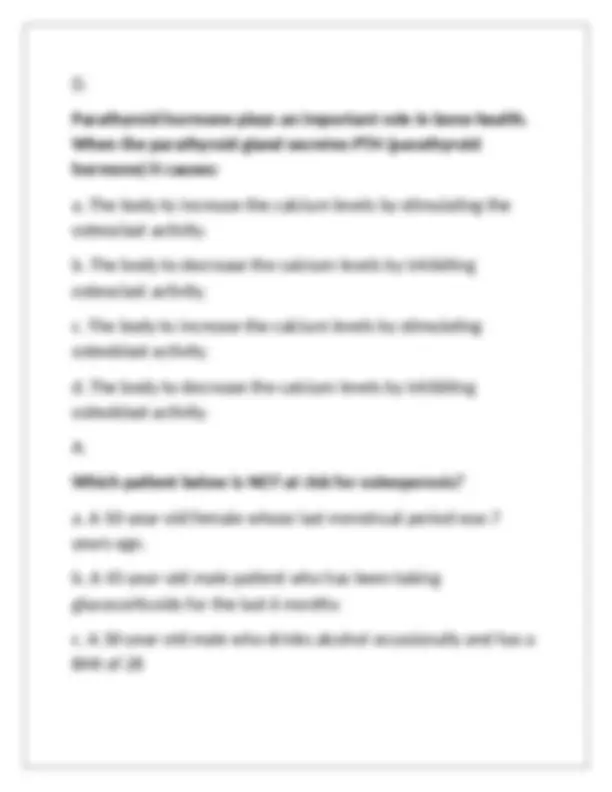
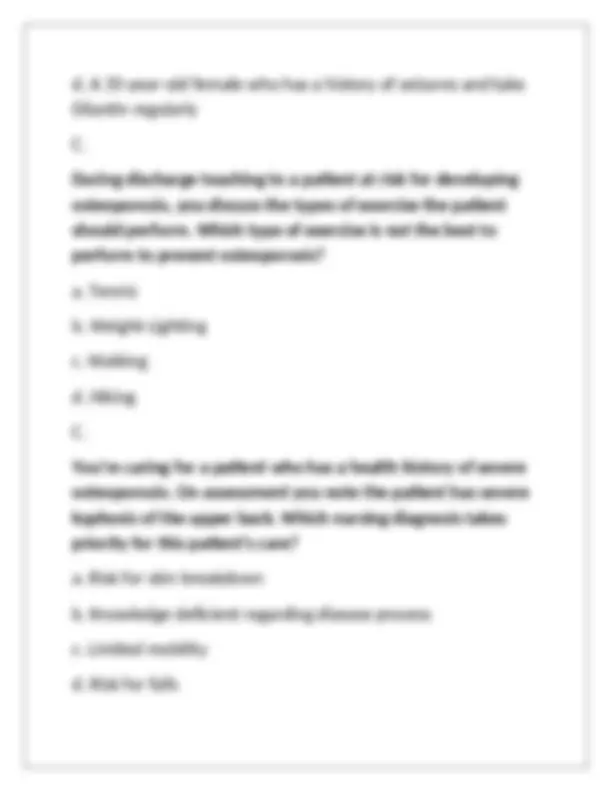
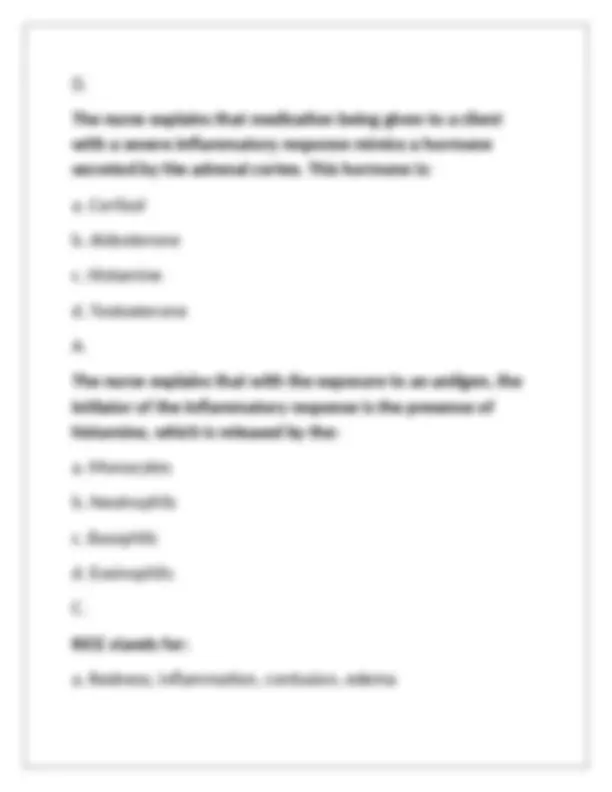
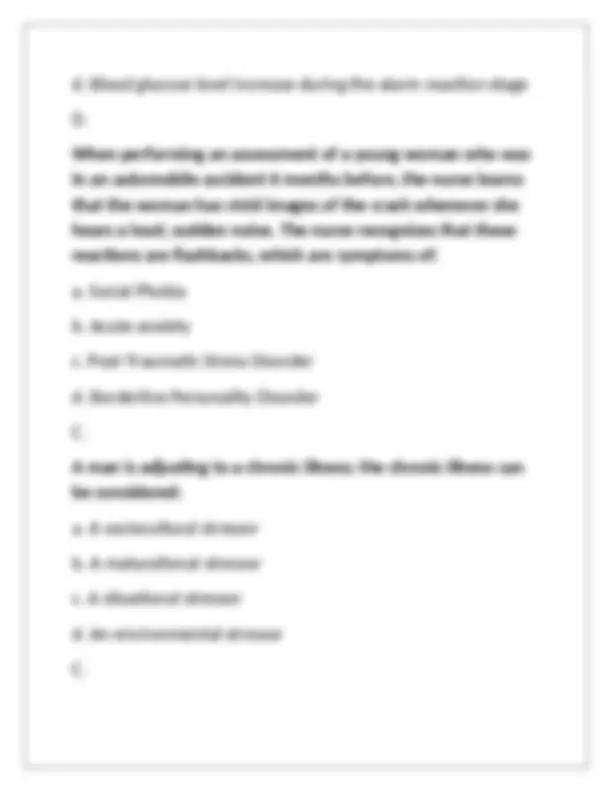
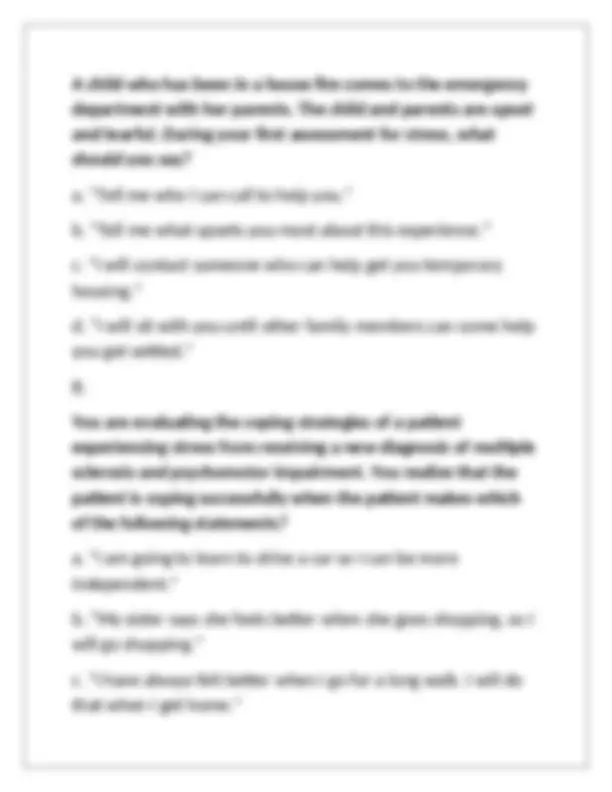
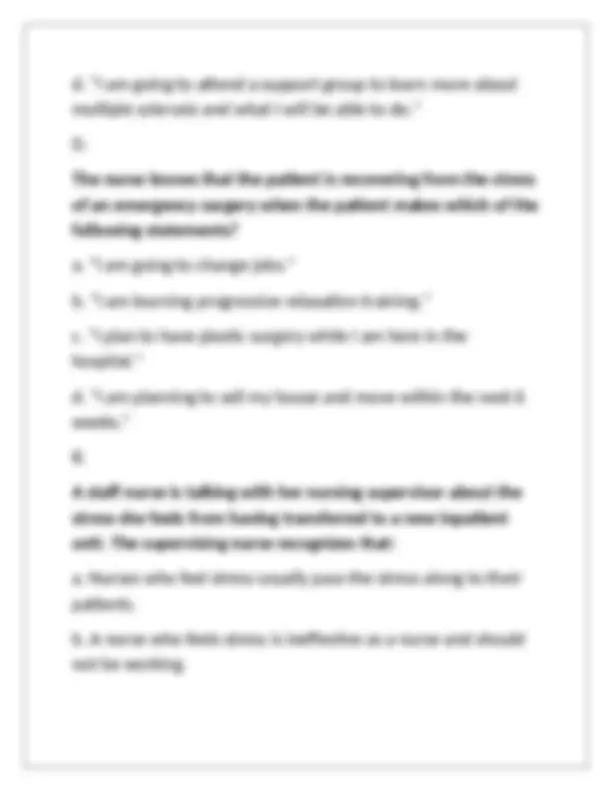
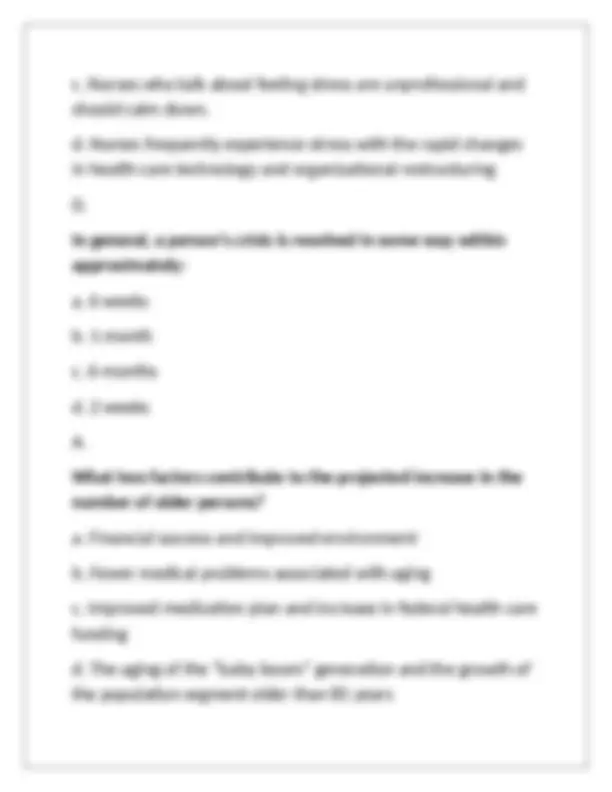
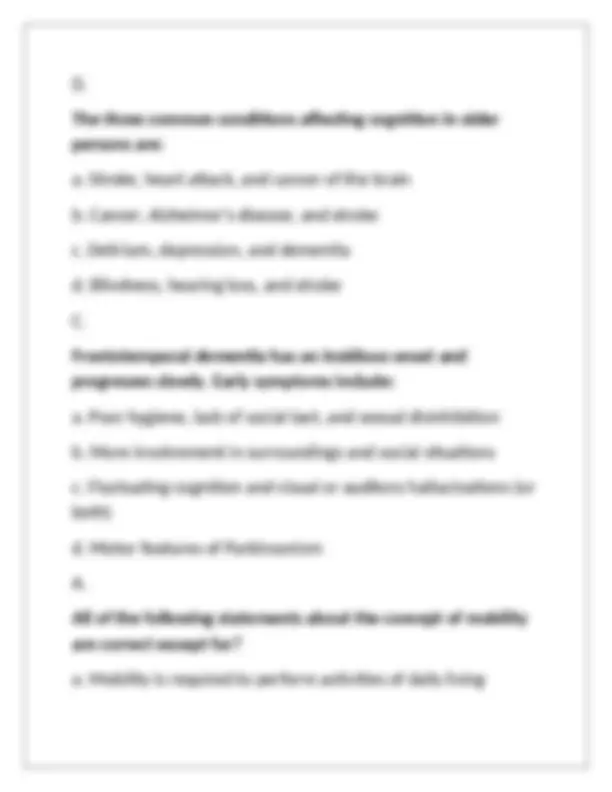
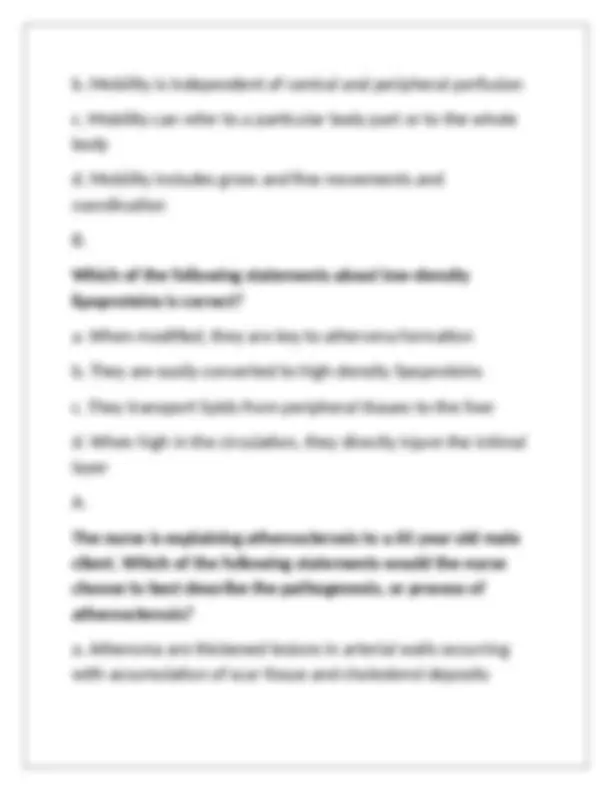
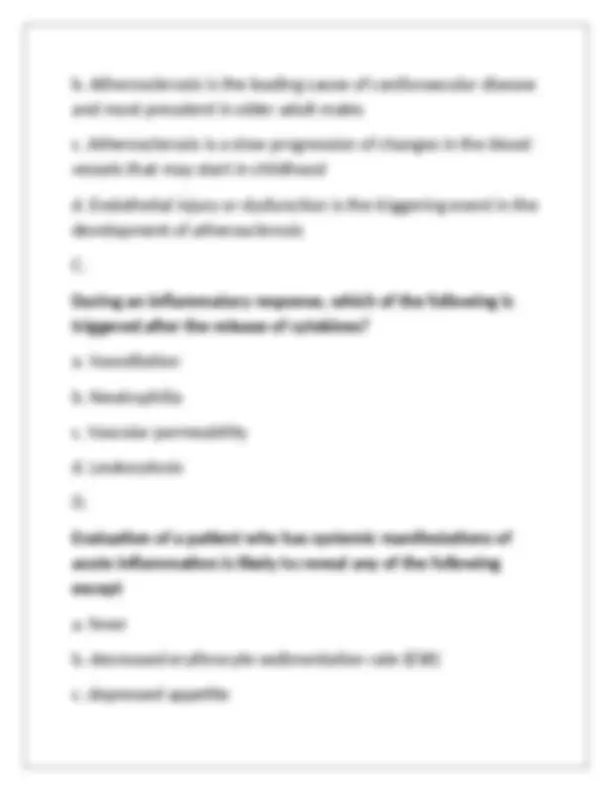
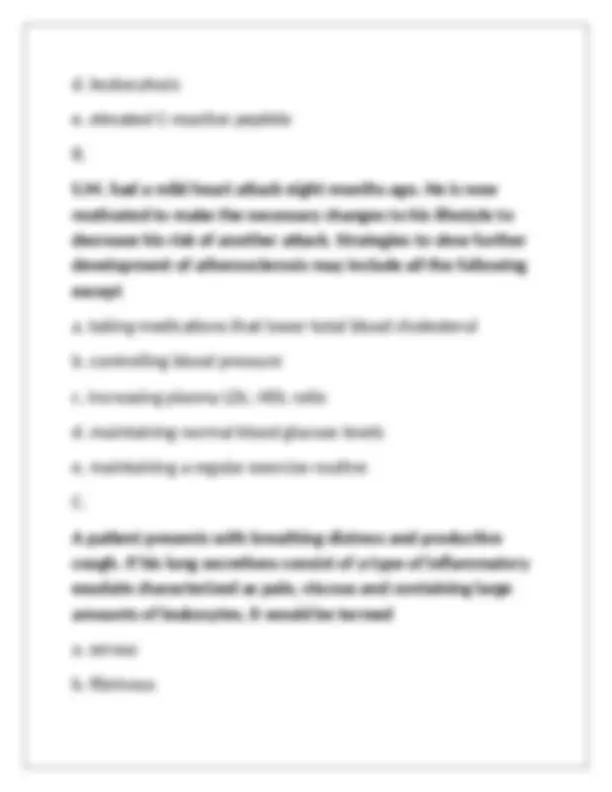
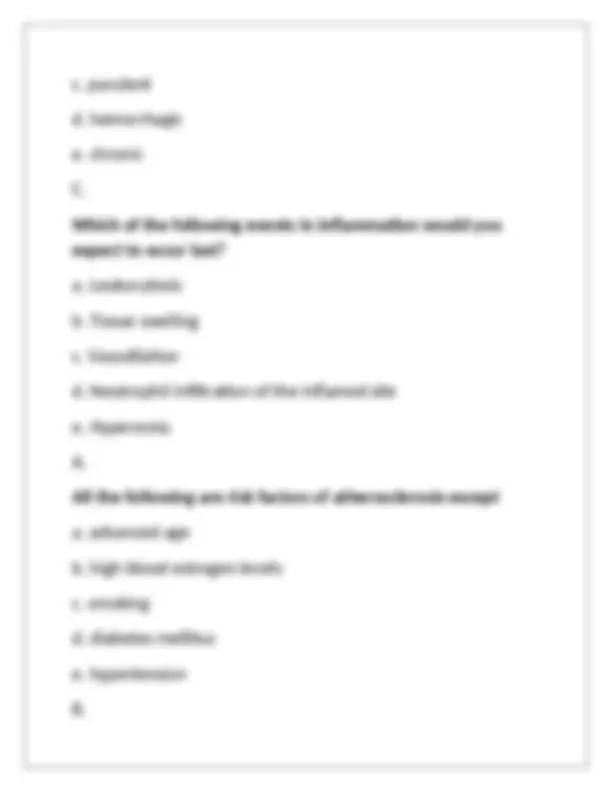
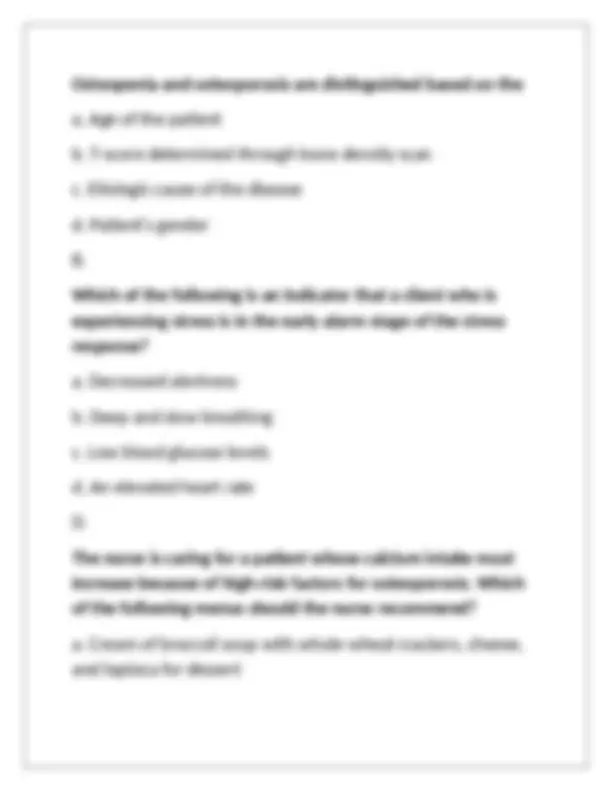
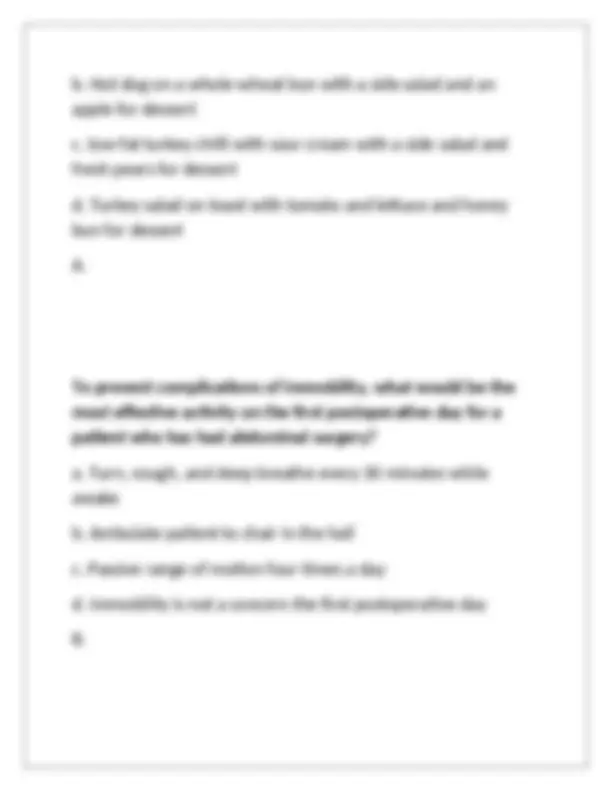
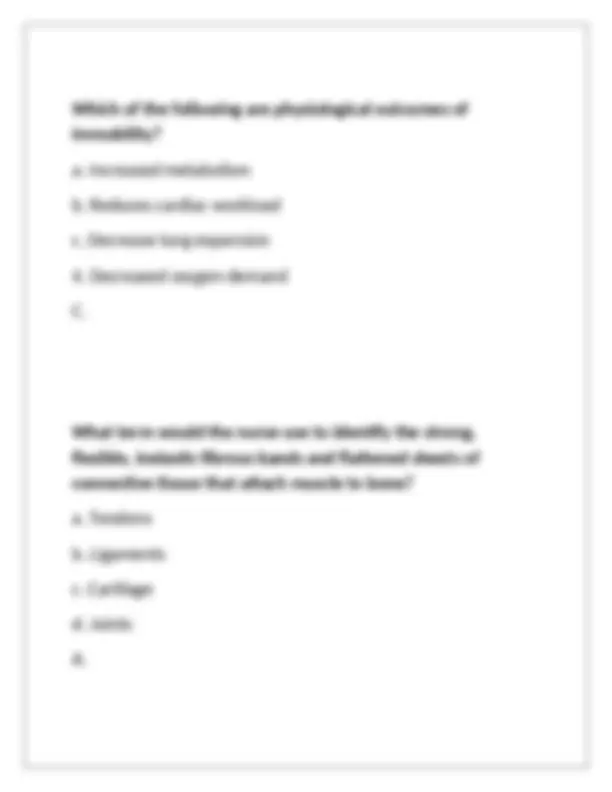
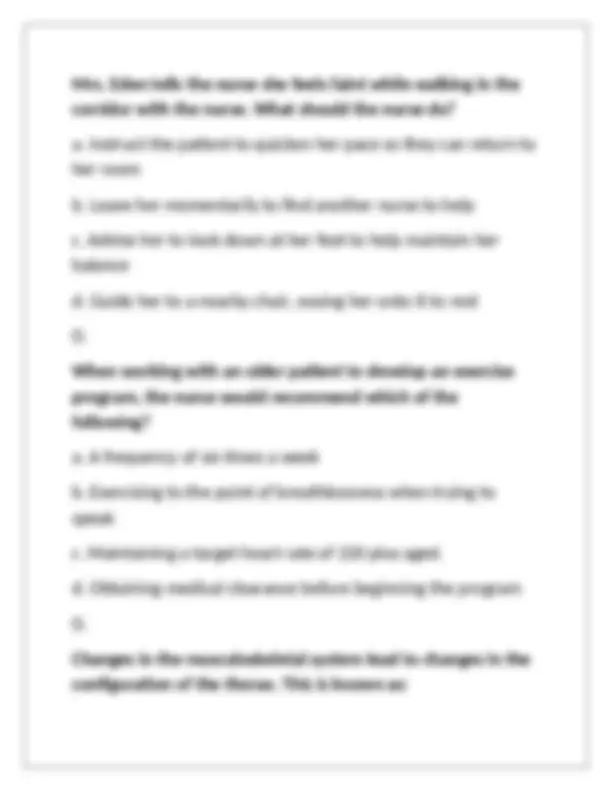
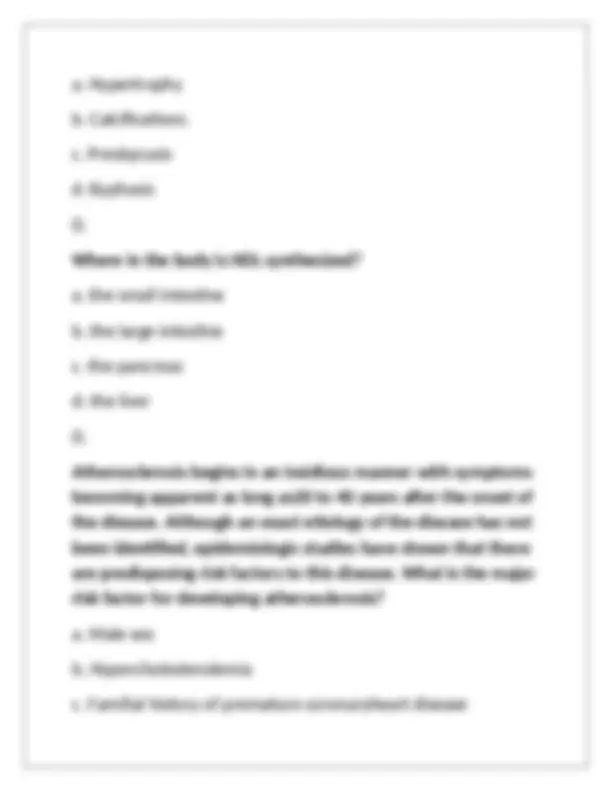
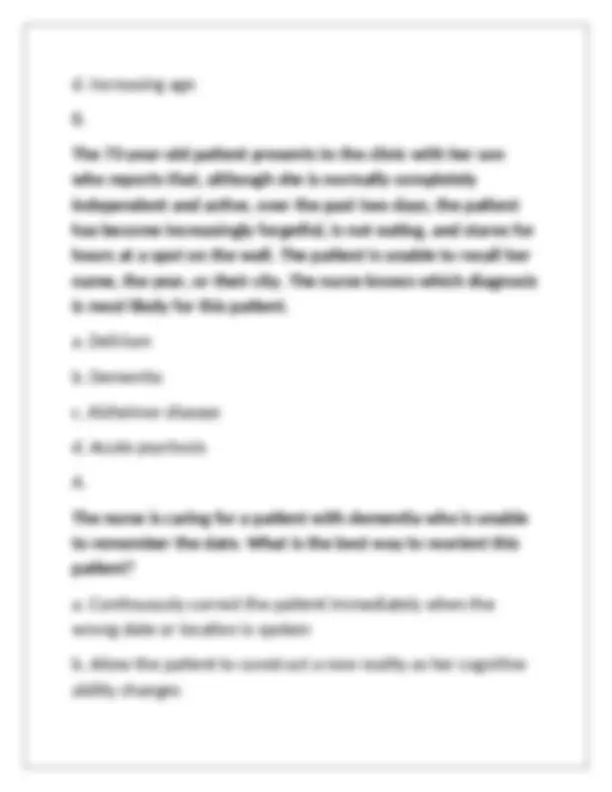
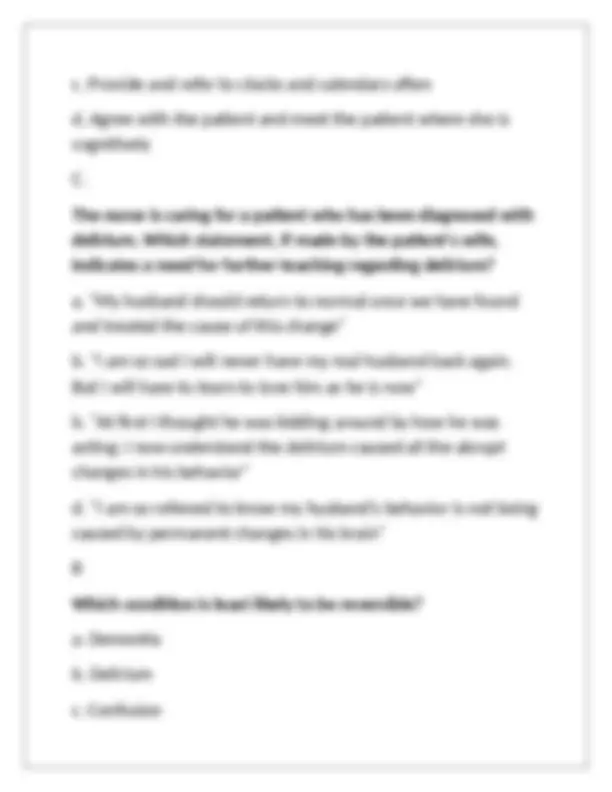
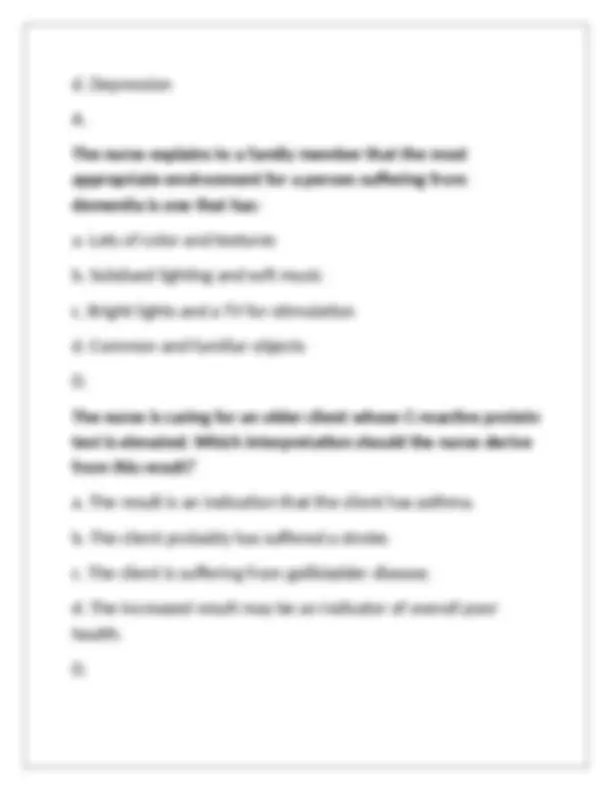
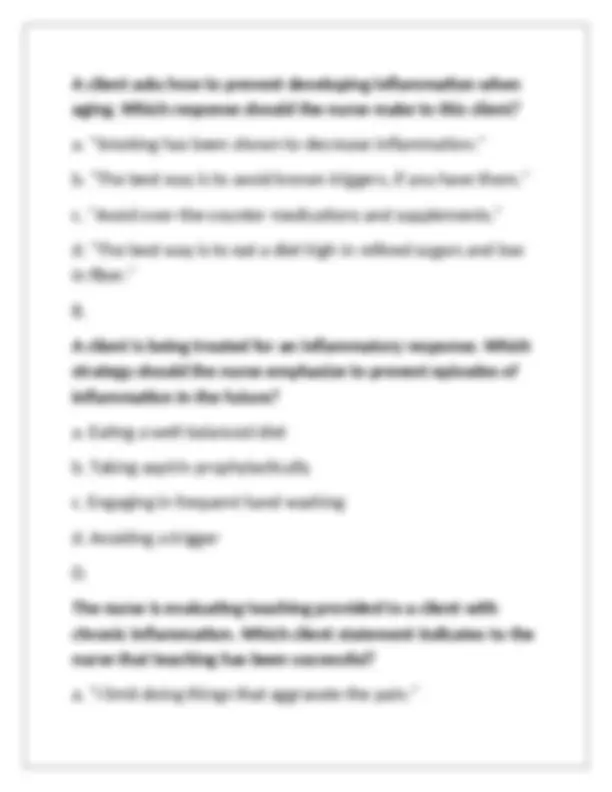
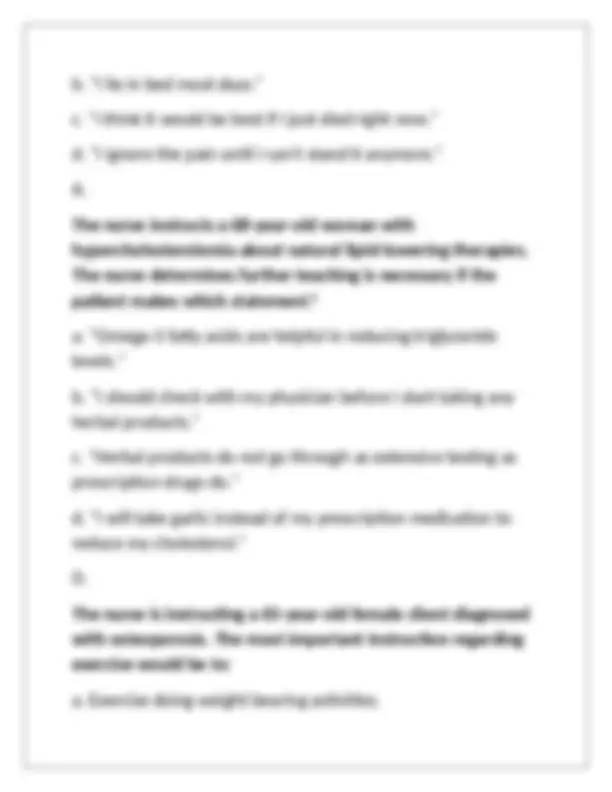
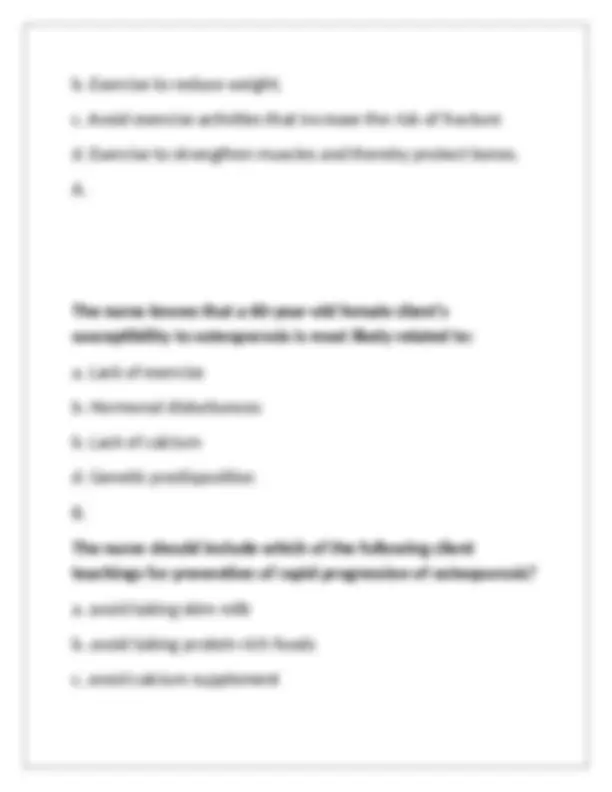
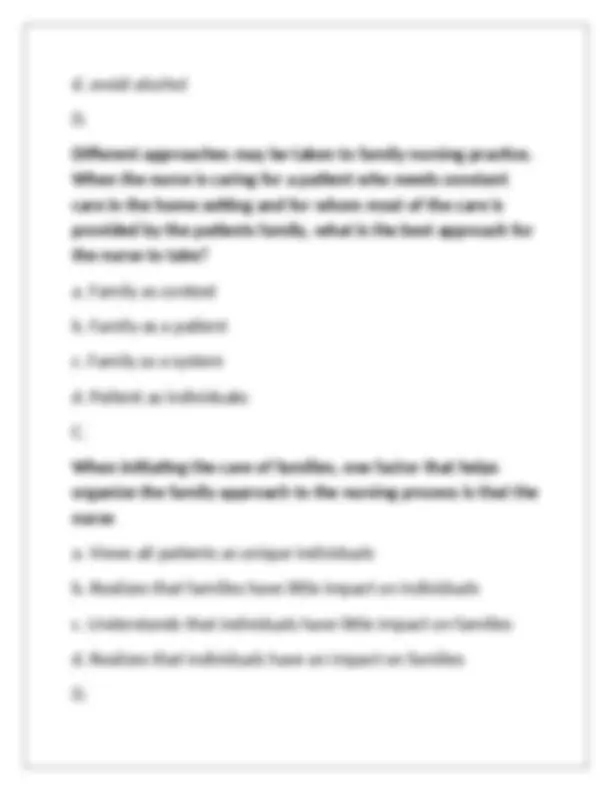
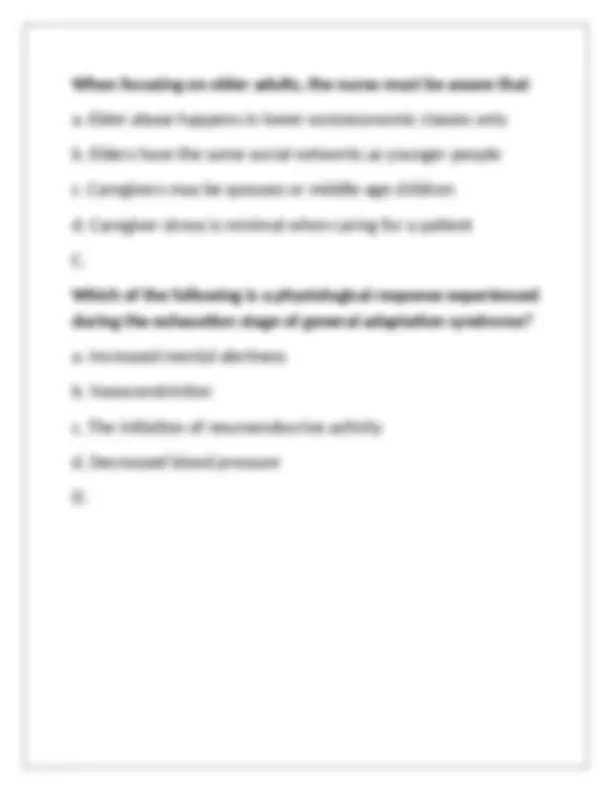


Study with the several resources on Docsity

Earn points by helping other students or get them with a premium plan


Prepare for your exams
Study with the several resources on Docsity

Earn points to download
Earn points by helping other students or get them with a premium plan
Community
Ask the community for help and clear up your study doubts
Discover the best universities in your country according to Docsity users
Free resources
Download our free guides on studying techniques, anxiety management strategies, and thesis advice from Docsity tutors
A set of practice questions covering various nursing concepts and principles relevant to the bsnc 1000 course. The questions address topics such as fall risk assessment, family dynamics, inflammation, bone remodeling, and osteoporosis. Each question includes a multiple-choice format with a correct answer and explanation. This resource can be valuable for students preparing for their final exam in bsnc 1000.
Typology: Exams
1 / 39

This page cannot be seen from the preview
Don't miss anything!
































BSNC 1000 - Final Practice Questions Textbook questions, power point questions, and additional questions With Complete Solutions A nurse is assessing an older adult's risk for falls. One of the questions that the nurse asks is whether the older adult has fallen in the past year. The nurse asks this because individuals who have fallen: a. Are more likely to sustain injuries if they fall again than persons who did not fall in the past year. b. Are most likely to have a balance disorder as compared to persons who did not fall in the past year c. Have most likely developed a fear of falling as compared to persons who did not fall in the past year. d. Have a higher risk of falling again than persons who did not fall in the past year. C. A middle-aged woman's father has passed away, and her mother requires physical and emotional help due to disabilities. The woman is married and raising two children, along with working full time. All of the factors described are a. Stressors b. Demands
c. Illnesses d. Stimuli A. A client expresses to the nurse that she constantly feels irritated and loses her temper. During the course of the interview, the nurse finds that the client takes care of her mother who was confined to bed following a stroke. The client struggles to balance caring for her family and her mother. Which nursing diagnosis would the nurse most likely identify for this client? a. Compromised family adjustment b. Caregiver role strain c. Ineffective coping d. Anxiety B. A nurse who is teaching a group of elderly women about the causes of osteoporosis explains that the disease can be caused by multiple factors. Which of the factors listed below are thought to contribute to osteoporosis? a. High estrogen secretion b. African ancestry
d. Caroline needs to take her mother to her doctor's appointment twice a month. C. A nurse is teaching a client about the potential benefits of the inflammatory response. The nurse's best explanation about the role of inflammation is that it is ultimately needed by the body to a. defend the injured site and prepare it for healing b. increase platelets at the site and facilitate clotting c. reduce blood flow to an injured area and reduce blood loss d. produce pain to warn against further injury A. A local infection and inflammation may lead to systemic effects such as malaise and muscle weakness in a patient. These symptoms likely develop as a result of a. pathogen-induced increase in body temperature b. release and action of cytokines c. the action of histamine d. generalized decreases in blood flow e. widespread actions of prostaglandins
Normal age-related changes in the nervous system can include all of the following except which one? a. Changes in sleep patterns b. Delayed reaction time c. Increased perception of pain d. Reduced blood flow to the brain e. Slower reflexes C. The nurse is assessing the way the client walks. Which of the following is the name for the manner of walking? a. Activity tolerance b. Body alignment c. Range of motion d. Gait D. When a client is using a cane for maximal support, the nurse is aware that the client should do which of the following?
a. Redness b. Heat c. Accumulation of fluid in the tissue d. Tissue shrinkage e. Pain D. Which of the following is an outcome of the inflammatory process that is considered to be most beneficial? a. Isolating and concentrating toxic substances in a local tissue b. Eliminating excess cells in a tissue c. Altering the functioning of tissue cells d. Defending the body and preparing an injured site for healing e. Softening injured tissues D. Interventions to control inflammation benefit the body by: a. Reducing pain b. Destroying invading pathogens c. Increasing tissue perfusion d. Reducing swelling of injured tissue
e. A and D E. Who should the nurse consider as family? a. Parents and their children b. People related by marriage, birth, or adoption c. The nuclear family and aunts, uncles, grandparents, and cousins d. A set of relationships that the patient identifies as family D. The patient is remarried, and her two children from a previous marriage live in the same household. Her husband's children visit on the weekend. This is an example of which form of family configuration: a. A nuclear family b. A blended family c. An extended family d. An alternative family B. What is the primary social context in which health promotion and disease prevention take place?
What does asking a patient “Who is in your family?” help the nurse assess? a. Internal structure b. External structure c. Context d. Instrumental functioning A. What is a goal of approaching family from a relational inquiry perspective? a. Professional collaboration b. Systematic problem solving c. Inquiry to understand the family in context d. Circular questions C. What are two of the components of relational inquiry? a. Using both open- and closed-ended questions b. Applying both a strict assessment format and corresponding interventions
c. Incorporating both letting be and emancipatory action d. Assessing the presenting problem and history of the presenting problem C. Emotional communication belongs to which CFAM subcategory? a. Instrumental functioning b. Developmental c. Internal structure d. Expressive functioning D. “What do you think when your husband won't visit your son in the hospital?” is an example of a circular question. What can asking the family circular questions accomplish? a. Facilitating change by inviting the family to discover their own answers b. Encouraging family members to be caregivers c. Validating their emotional responses d. Targeting specific yes or no answers A.
Parathyroid hormone plays an important role in bone health. When the parathyroid gland secretes PTH (parathyroid hormone) it causes: a. The body to increase the calcium levels by stimulating the osteoclast activity. b. The body to decrease the calcium levels by inhibiting osteoclast activity. c. The body to increase the calcium levels by stimulating osteoblast activity. d. The body to decrease the calcium levels by inhibiting osteoblast activity. A. Which patient below is NOT at risk for osteoporosis? a. A 50-year-old female whose last menstrual period was 7 years ago. b. A 45-year-old male patient who has been taking glucocorticoids for the last 6 months c. A 30-year-old male who drinks alcohol occasionally and has a BMI of 28
d. A 35-year-old female who has a history of seizures and take Dilantin regularly C. During discharge teaching to a patient at risk for developing osteoporosis, you discuss the types of exercise the patient should perform. Which type of exercise is not the best to perform to prevent osteoporosis? a. Tennis b. Weight-Lighting c. Walking d. Hiking C. You're caring for a patient who has a health history of severe osteoporosis. On assessment you note the patient has severe kyphosis of the upper back. Which nursing diagnosis takes priority for this patient's care? a. Risk for skin breakdown b. Knowledge deficient regarding disease process c. Limited mobility d. Risk for falls
b. Rest, isolation, compression, elevation c. Review, intervention, continuation, evaluation d. Rest, ice, compression, elevation D. Is it common for acute inflammation to last a week or longer? a. True b. False B. Changes in blood flow represent the body’s first response to injury. a. True b. False A. What is the name of the phenomenon where WBC's marginate and become attached to the edge of the endothelium? a. Cementing b. Pavementing c. Margination
d. Adhesion B. Margination of Neutrophils is the first cellular change of inflammation a. True b. False A. The vital functions necessary for survival, which include heart rate, blood pressure, and respiration, are controlled by the: a. Medulla Oblongata b. Reticular formation c. Pituitary gland d. Limbic system A. While assessing a person for effects of the general adaptation syndrome, the nurse should be aware that: a. Heart rate increases in the adaptation state b. Blood volumes increases in the exhaustion stage c. Vital signs return to normal in the exhaustion stage
A child who has been in a house fire comes to the emergency department with her parents. The child and parents are upset and tearful. During your first assessment for stress, what should you say? a. “Tell me who I can call to help you.” b. “Tell me what upsets you most about this experience.” c. “I will contact someone who can help get you temporary housing.” d. “I will sit with you until other family members can come help you get settled.” B. You are evaluating the coping strategies of a patient experiencing stress from receiving a new diagnosis of multiple sclerosis and psychomotor impairment. You realize that the patient is coping successfully when the patient makes which of the following statements? a. “I am going to learn to drive a car so I can be more independent.” b. “My sister says she feels better when she goes shopping, so I will go shopping.” c. “I have always felt better when I go for a long walk. I will do that when I get home.”
d. “I am going to attend a support group to learn more about multiple sclerosis and what I will be able to do.” D. The nurse knows that the patient is recovering from the stress of an emergency surgery when the patient makes which of the following statements? a. “I am going to change jobs.” b. “I am learning progressive relaxation training.” c. “I plan to have plastic surgery while I am here in the hospital.” d. “I am planning to sell my house and move within the next 6 weeks.” B. A staff nurse is talking with her nursing supervisor about the stress she feels from having transferred to a new inpatient unit. The supervising nurse recognizes that: a. Nurses who feel stress usually pass the stress along to their patients. b. A nurse who feels stress is ineffective as a nurse and should not be working.